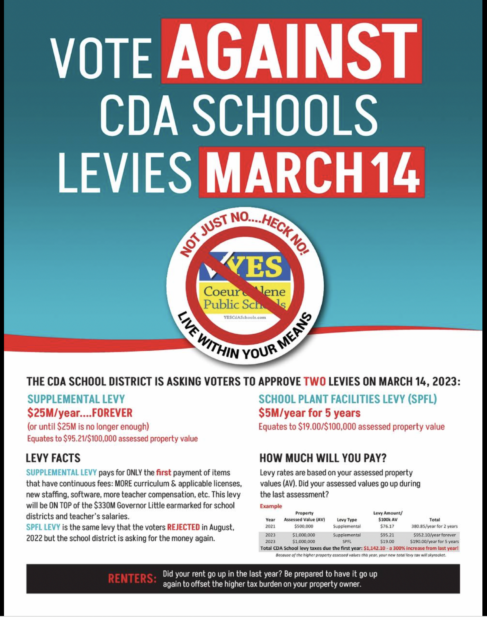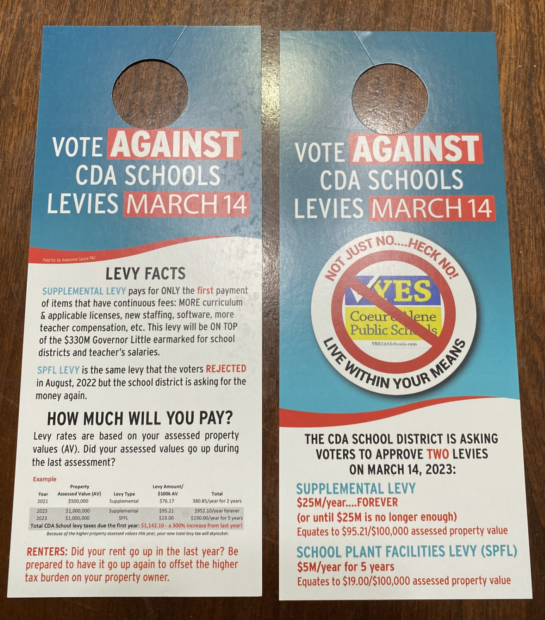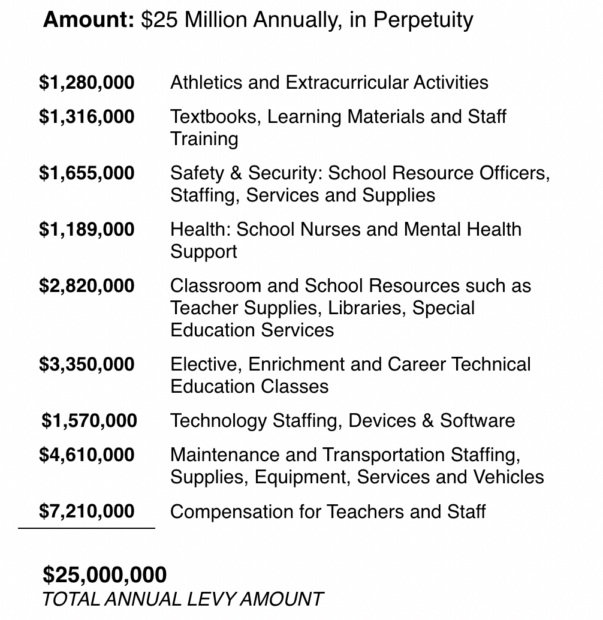Coeur d’Alene School District officials on Wednesday called out what they termed a “bogus,” “disgusting,” “unethical and un-American” disinformation campaign about its two upcoming ballot initiatives — a $25 million perpetual supplemental levy and a five-year, $25 million plant facilities levy.
The measures will appear on the ballot on March 14.
“Households in the Coeur d’Alene School District are being subjected to a last-minute campaign to confuse voters,” a district press release read.
“It is regrettable that a group would use bogus facts to confuse and scare voters this close to the election,” Superintendent Shon Hocker said.
Casey Morrisroe, vice chair of the board of trustees, also condemned the “efforts to twist the facts and mislead voters.”
“It’s disgusting that a group would purposefully misrepresent the tax cost of the district’s levy in an effort to scare residents into voting no,” Morrisroe said. “Voters have a right to have accurate election information, which is why I feel compelled to speak out. In this case, I find this flier to be unethical and un-American.”
The district’s comments were sparked by fliers and doorknob hangers that were distributed to households.


It’s not clear which group or individual made and distributed the items, but these screenshots were taken from a Facebook page called “CDA School Levy.” The group also has a website where community members can download and distribute the informational materials.
Here’s some basic information about each levy that is represented the same way on the district webpage and on the anti-levy group’s materials:
| Levy type | Annual amount | Estimated cost per $100K of taxable assessed value |
| Supplemental levy | $25 million/year in perpetuity | $95.21 |
| Safety and maintenance/school plant facilities levy | $5 million/year for 5 years ($25 million total) | $19.04 |
Where the district and anti-levy group disagree is on how much homebuyers should expect to pay per year if both levies passed.
The anti-levy group’s materials estimate how much a taxpayer with a home assessed at $500,000 in 2021 would be paying in 2023 if the levies passed. The fliers predict that the home would double in assessed value to $1 million. In that case, the homeowner would be paying $1,142.10/year for both levies.
“Because of the higher property assessed values this year, your new total levy tax will skyrocket,” the flier says.
More than $1 billion in taxpayer money will be on the line when school districts go to the polls on March 14. Here’s a district-by-district breakdown.
In its press release, the district makes its estimate based on a home valued at $500,000, not $1 million. In that case, a homeowner would see an estimated increase of $138.75 annually, according to the district.
How to account for the $1,000 difference in their math?
Part of it is the anti-levy group’s assumption that a $500,000 house in 2021 will double in assessed value by 2023. And part of it is that the district’s estimate is based on the increase a taxpayer will see, and takes into account the homeowner’s exemption.
This year’s levies, if passed, would replace a two-year levy that expires on June 30, and currently costs $76.17 per $100,000 of taxable value. Right now, the owner of a home assessed at $500,000 is paying about $360/year for the existing levy (with the homeowner’s exemption factored in). The new levies (if both pass) would cost that same homeowner (assuming the house value remains static) $498.75/year.
The difference, or increase, is about $138.75/year.
The school district provides a levy calculator that homeowners can use to determine how much their taxes would increase if both levies passed.
The district and levy group also disagree on other information.
According to the flier, the district’s safety and maintenance levy “is the same levy that voters rejected in August, 2022 but the school district is asking for the money again.”
The district did put a plant facilities levy on the ballot in August, and it did fail — but it was a 10-year, $80 million levy, as opposed to the proposed five-year, $25 million safety and maintenance levy in question.
The flier also states that the supplemental levy “pays for ONLY the first payment of items that have continuous fees: MORE curriculum & applicable licenses, new staffing, software, more teacher compensation, etc.”
“I have no idea what the heck they’re talking about,” Hocker said when asked about that.
According to the school district, the supplemental levy would cover a quarter of the district’s annual operating funds. The bulk of it ($7.2 million) would go toward teacher and staff compensation.
Here’s a complete list of how the district would spend the $25 million annually:

Hocker said the perpetual levy could save taxpayer money in the long run. For example, the district wouldn’t have to spend “hundreds of thousands of dollars” every two years to educate the public about the newest levy. The district also wouldn’t be increasing the levy amount every two years to account for inflation — it would be locked in at a set price. It is possible that the school board could ask for more funding in the future on top of the perpetual levy, but that would be “highly doubtful,” Hocker said.
The perpetual, $25 million levy requires a simple majority to pass.
Most supplemental levies run only one to two years, subject to renewal. But Coeur d’Alene is using a state law that allows for a permanent levy with simple majority support. Districts can seek permanent taxing authority if a levy has been on the books for at least seven straight years, and if it accounts for at least a fifth of the district’s maintenance and operations fund.
The separate plant facilities levy would go largely into deferred maintenance, with a total of $2.5 million going toward safety and security. A full list of those projects can be found here. It would require a 55% majority to pass.
